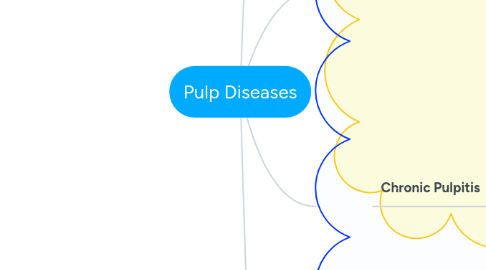
1. Periapical lesions
1.1. Periapical abscess
1.1.1. Accumulation of ACUTE inf. cells at the apex of NON-vital tooth
1.2. Causes
1.2.1. Untrated pu;p necrosis
1.2.2. Trumatic injury
1.2.3. Wrong RCT
1.2.4. (Phoenix abscess) Acute exacerbation of chronic periapical lesion ,, Like granuloma or cyst
1.3. C/P
1.3.1. Local Manifestation
1.3.1.1. History of previous pulpitis
1.3.1.2. thermal change does NOT induce pain
1.3.1.3. tooth extremely painful
1.3.1.4. Sever throbbing pain
1.3.1.5. Sensitive to PERCUSSION
1.3.1.6. Tooth is slightly extruded
1.3.1.7. Abscess may point intraorally or extraorally (opening is gumboil or parulis)
1.3.2. Systemic manifestation
1.3.2.1. Fever & Malaise
1.3.2.2. Enlaged regional lymphs and tender
1.4. H/F
1.4.1. Area of Liquifactive N. composed of
1.4.1.1. Exudates
1.4.1.2. Necrotic tissue
1.4.1.3. Pus (PMNL)
1.4.1.4. Dilated BV
1.5. X-ray
1.5.1. No significant alteration
1.5.2. With progression you may find
1.5.2.1. Widening of PDL Space
1.5.2.2. Less defined Lamina dura
1.5.3. This due to insufficient time for bone destruction
2. In both acute pulpitis and periapical abscess the tooth is painful but in pulpitis the pain is increased with thermal changes while in abscess thermal change does not induce pain
3. Focal Reversible Pulpitis
3.1. Definition
3.1.1. Pulp hyperemia, one of earliest forms of pulpitis, localized to irrigated region.
3.2. Causes
3.2.1. Odontoiatrogenic
3.3. C/P
3.3.1. Sudden, Short duration pain.
3.3.2. Mild to moderate pain.
3.3.3. Thermal sensitivity esp. cold.
3.4. H/F
3.4.1. VD & Hyperemia
3.4.2. Inflammatory exudate (Edema fluid).
3.4.3. Extravasation OR Diapedesis
3.4.4. Stasis -> Thrombosis
3.4.5. Odontoblasts are intact
3.5. Treatment
3.5.1. Removal of the irritant.
4. Acute Pulpitis
4.1. Definition
4.2. Causes
4.2.1. Progression of FRP.
4.2.2. Acute exacerbation of chronic pulpitis
4.3. C/P
4.3.1. Severe, constant, lancinating, radiating, and continuous.
4.3.2. Continue after stimuli removal
4.3.3. increase with hot and cold
4.3.4. increase at night
4.3.4.1. Mild, Dull, Intermittent pain
4.3.5. radiating so pt cannot localize the pain
4.3.5.1. Upper by -> Zygomaticotemporal Nerve
4.3.5.2. Lower by -> Auriculotemporal Nerve
4.3.6. Tooth is NOT sensitive ti percussion.
4.3.6.1. Pain Disappear after removal of stimuli
4.4. H/F
4.4.1. Odontoblasts are DESTRUCTED.
4.4.2. Increased PMNC
4.4.3. Pus due to death of PMNC (Liquifactive Necrosis).
4.4.4. Partial (at pulp horns) then Total Supurative pulpitis.
4.4.4.1. If irritation is not sever enough to cause acute pulpitis
4.4.4.1.1. Low virulent of organism
4.4.4.1.2. Slow progression of caries
5. Chronic Pulpitis
5.1. Definition
5.1.1. Persistence of inflammation with continuous attempts of repair.
5.2. Causes
5.2.1. Sequelae of acute inflammation
5.3. C/P
5.3.1. Reaction to thermal change is lower than acute pulpitis.
5.3.2. Pt. can cope with pain for several days.
5.4. P/F
5.4.1. Considerable amount of reactionary dentin is formed.
5.4.2. Dentin Bridge is poorly formed.
5.4.3. Pioneer bacteria
5.4.4. The pulp show
5.4.4.1. Chronic inflammatory cells (Plasma & Lymphocytes)
5.4.4.2. Prominent B.Cap.
5.4.4.3. Collagen fibers (an attempt of the pulp to wall off the infection)
5.5. Types of chronic pulpitis
5.5.1. Closed
5.5.2. Open
5.5.2.1. Chronic Ulcerative Pulpitis
5.5.2.1.1. Pulp is not covered by epithelium and exposed C.T.
5.5.2.1.2. Pulp tissue beneath as granulation T. & Chronic inf. cells.
5.5.2.2. Chronic Hyperplastic Pulpitis (Pulp Polyp)
5.5.2.2.1. Definition
5.5.2.2.2. C/P
5.5.2.2.3. H/F
6. Pulp Necrosis
6.1. Definition
6.1.1. Death of the pulp, End result of pulpitis
6.2. H/F
6.2.1. Empty Pulp champer
6.3. Treatment
6.3.1. Endo ttt
6.3.2. Extraction
